For UC Berkeley, 2021 was a year of deep reflection and great achievement
Here’s a look back at the top Berkeley News stories of the year
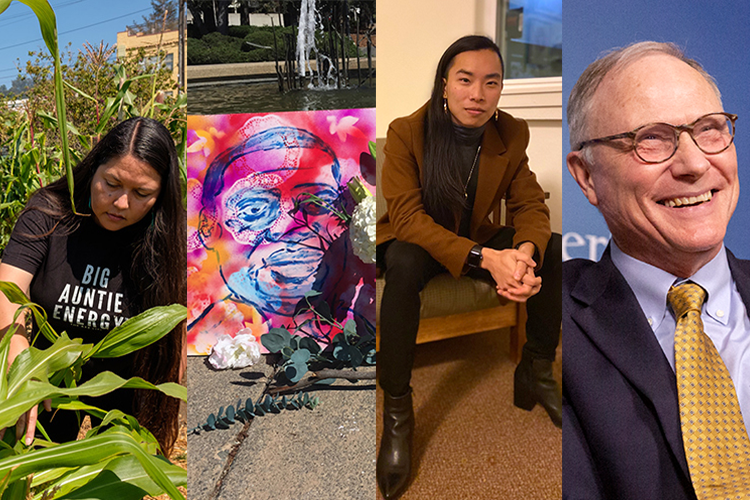
December 14, 2021
For UC Berkeley, 2021 was a year of deep reflection on some of the world’s most important issues, from the tenuous nature of democracy and the elusiveness of racial justice to how people are surviving — even thriving — in an ongoing pandemic.
When the campus community wasn’t weighing in on today’s issues, faculty were making discoveries and celebrating achievements. Professor David Card won a Nobel Prize in Economics for his work that challenged orthodoxy and shifted understanding of inequality and the social and economic forces that impact low-wage workers. It was the campus’s third Nobel Prize win in the past two years.
And, through it all, the campus continued to strengthen its commitment to creating a more inclusive community for its students, staff and faculty. Here’s a look back at the top Berkeley News stories of the year.
January

Native Americans on campus, in California and beyond, supported the proposal to unname Kroeber Hall. Among them, from left, are Berkeley senior Cheyenne Two Feathers Tex and Ph.D. students Ataya Cesspooch and Alexii Sigona, and Berkeley staff member Phenocia Bauerle. (UC Berkeley photo by Irene Yi)
Kroeber Hall, honoring anthropologist who symbolizes exclusion, is unnamed
In January, UC Berkeley’s Kroeber Hall became the fourth building on campus to be stripped of its name in a year’s time. The decision by Berkeley officials capped a formal review process and was made, in large part, because the building’s namesake — Alfred Louis Kroeber, born in 1876 and the founder of the study of anthropology in the American West — is a powerful symbol that continues to evoke exclusion and erasure for Native Americans.
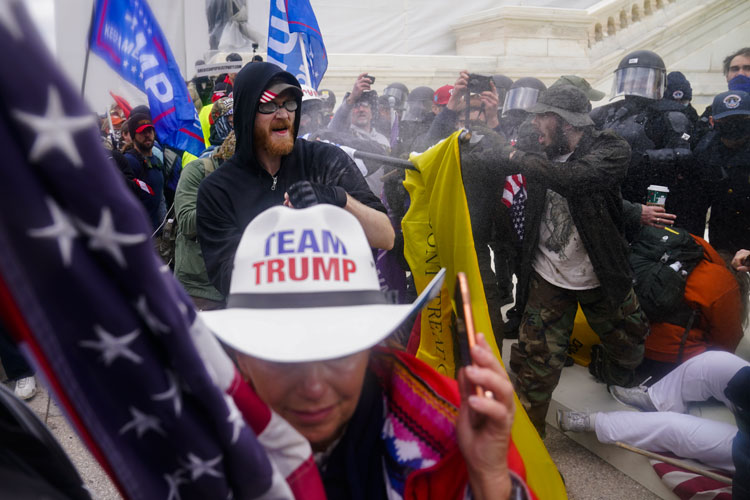
Trump supporters try to break through a police barrier at the U.S. Capitol in Washington. (AP Photo by John Minchillo)
Berkeley scholars’ outrage, reflections on U.S. Capitol mob siege
A day after the Jan. 6 storming and siege of the U.S. Capitol, UC Berkeley scholars expressed their views about the attempted coup that shook the world and the issues it raises, including the GOP’s enabling of President Trump’s delusions about overturning the election, a pernicious double standard in policing along racial lines, a lack of preparation by law enforcement and congressional leadership for the disputed certification of electoral college votes, and the coddling of white supremacists and domestic terrorists.
Also, read: Biden must mount campaign against right-wing extremists, says Berkeley expert, Why were Trump loyalists allowed to storm the Capitol?, At a time of crisis, Berkeley policy experts join Biden administration.
February

UC Berkeley Ph.D. candidate Alberto Sanchez-Sanchez said that working on the historic landmark that he’s purchased in his hometown of Used, Spain, is “keeping me busy, bringing me joy” as he waits for the coronavirus pandemic lockdown to end. (Studio Goonie photo by José Andrés Sánchez)
COVID Stories: Restoring a 17th century manor in Spain
In the fourth story in a series of stories about how members of the campus community were surviving — and even thriving — during the COVID-19 pandemic, Alberto Sanchez-Sanchez, a Ph.D. candidate in architecture at the College of Environmental Design, discusses how he restored a 17th century manor in Spain. Read more COVID Stories.

UC Berkeley engineer Karl van Bibber and his team of students and postdoctoral researchers are part of a collaboration that has built the most sensitive detector ever for spotting theoretical subatomic particles called axions. If their experiment succeeds, it could revolutionize our understanding of dark matter. (Photo by Brittany Hosea-Small)
Researchers harness quantum weirdness to speed the search for dark matter
In a paper published in February in the journal Nature, a collaboration of physicists and engineers from across the country described a new experiment that harnesses the weirdness of quantum mechanics to accelerate the search for the axion, one of two leading hypothetical subatomic particles that may make up the bulk of dark matter in the universe.
March

Theater, Dance and Performance Studies students perform in the virtual play, Unstable Connection. (Photo courtesy of Anna Maria Sharpe)
Berkeleyans share their year of change, distance, loss and service
In March, it had been a year since Chancellor Carol Christ sent a message to all 60,000 members of the campus community announcing that UC Berkeley would be switching to remote learning, canceling events for more than 150 people and asking most workers to do their jobs from home. Berkeley News talked with students, faculty and staff across campus about their experiences over that year.
Also, read: Chancellor Carol Christ: Reflecting on a year like no other and Spring semester 2021: Pandemic-era Berkeley in 40 photos.

The structural and historical roots of anti-Asian racism in the U.S. are part of contemporary Asian American race relations. This illustration shows an anti-Chinese labor meeting on March 20, 1880 outside of San Francisco City Hall. (Photo via Illustrated Newspaper)
Berkeley expert: In times of crisis, anti-Asian violence is an American tradition
March’s mass shootings at a string of massage parlors in the Atlanta area left eight people dead, including six people of Asian descent. Those killings — along with a rise in anti-Asian attacks in major cities — are an unsurprising reminder of the long history of anti-Asian violence in America, said UC Berkeley Asian American studies associate professor Lok Siu. Berkeley News spoke with Siu about how economic and capitalistic structures can produce racial violence, and why it is important for communities of color to come together to fight anti-Asian violence and racism.

Doe Library in February 2018. (UC Berkeley Library photo by J. Pierre Carrillo)
UC announces breakthrough open access deal with publishing giant Elsevier
Two years after cutting ties with publishing industry giant Elsevier, producer of more than 2,600 scholarly journals, the University of California system today announced in March that it has reached with Elsevier the largest open access agreement of its kind in North America.
April
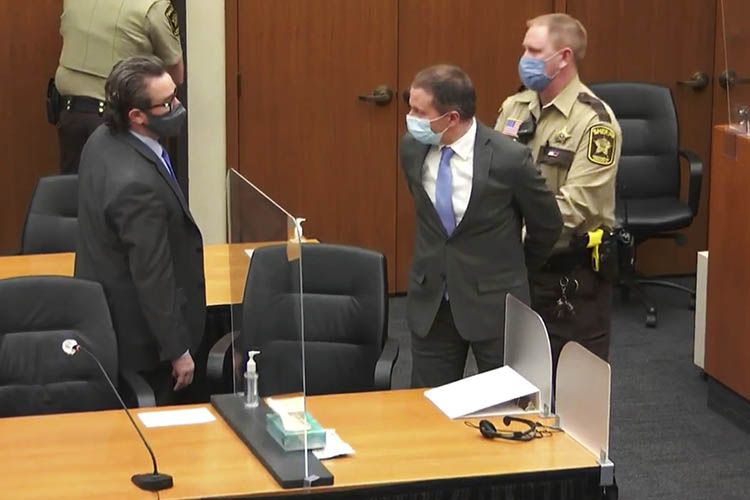
Derek Chauvin’s conviction for murder and manslaughter probably rested heavily on the shocking video of Floyd pinned to the ground, says a UC Berkeley expert. (Court TV photo via AP)
‘Cinematic’ video, police condemnation sealed guilty verdict in Chauvin trial
In a trial with profound implications for racial justice and policing in America, a Minnesota jury in April found former Minneapolis Police Officer Derek Chauvin guilty of murder and manslaughter in the death of George Floyd nearly 11 months ago. The verdict, says UC Berkeley law professor Jonathan Simon, probably rested heavily on the shocking video of Floyd pinned to the ground and on powerful testimony by police leaders against the former officer.
Also, read: UC Berkeley leaders: Chauvin verdict delivers ‘a measure of justice’, Guilty: Berkeley campus community reflects on Derek Chauvin trial verdict and listen: Berkeley MFA student Fred DeWitt: George Floyd never wanted to be in my art.

“President Joe Biden changed course forever Saturday, joining historians and many other nations in declaring that the Ottoman Empire’s slaughter of an estimated 1.5 million Armenian civilians was genocide,” writes staffer Roxanne Makasdjian. (Photo by Justin Kaladjian)
As Biden recognizes Armenian Genocide, one Berkeleyan reflects
“It’s 1968 and near the end of April,” wrote Roxanne Makasdjian, director of broadcast communications in Berkeley’s Department of Communications and Public Affairs, in April. “A feeling of sheer joy comes over me as I do barrel rolls down the hill where the new Armenian Genocide monument was being consecrated in Montebello, Calif. I’m 6 years old, oblivious to the meaning of the day, feeling like I had hit the jackpot — a smooth, grassy hill of just the right incline to allow for an exciting speed without fear of injury.
“Coasting blissfully downhill, I was not yet aware of the painful, formidable history that had brought these thousands of Armenians to that hill on that day and on every Armenian Genocide commemoration day thereafter. But it didn’t take long to learn that all four of my grandparents were among the few survivors of the genocide perpetrated by the Turkish leadership of the Ottoman Empire in 1915, wiping out the Armenian civilization living on its historic homeland, and expropriating all their personal and community properties.”
May

Philip (left) with his father, Dr. Wilfred Gotanda, and older brother, Neil, at Lake Tahoe, California. (Photo courtesy of Philip Kan Gotanda, copyright Diane Takei 2021)
Playwright Philip Kan Gotanda on growing up in California post-World War II
Philip Kan Gotanda is a professor in UC Berkeley’s Department of Theater, Dance and Performance Studies and one of the most prolific playwrights of Asian American-themed work in the United States. In the first podcast episode of a three-part series, Gotanda talks about growing up in Stockton, California, after World War II and the anti-Japanese racism that he couldn’t name as a child, but that he’d go on to write about as an adult.
Also, listen: How the Asian American movement began at Berkeley, sparked creativity and unity and How do we talk about the Asian experience with Asians at the center?

Its seats may be empty, but the Greek Theatre is busy for five days this week as more than 6,400 graduates cross its stage one at a time — 30 every 10 minutes — during the pandemic, savoring their only chance to wear regalia, receive a scroll and be congratulated by a campus leader. (Photo by Brittany Hosea-Small)
The longest procession: Five full days, 6,400 graduates, one at a time
In May, the campus devised a livestreamed, five-day, in-person procession of 2021 Berkeley graduates to give students what they said they wanted most at a pandemic-era graduation: the opportunity to walk across the stage and receive something physically tangible from an academic leader, to give them a sense of closure.
Also, listen: Wally Adeyemo to graduates: You are prepared to shape the world and read: Top graduating senior a tech whiz and gifted musician. Read more graduation stories and graduate profiles.
June

Cows rest near a cave in Yunnan, China, where horseshoe bats were found carrying a virus that closely resembles SAR-CoV-2. A new analysis finds that the expansion of concentrated livestock production in China may be creating favorable conditions for coronaviruses to jump from horseshoe bats to domesticated animals before infecting humans. (AP photo by The Yomiuri Shimbun)
Analysis reveals global ‘hot spots’ where new coronaviruses may emerge
Global land-use changes — including forest fragmentation, agricultural expansion and concentrated livestock production — are creating “hot spots” favorable for bats that carry coronaviruses and where conditions are ripe for the diseases to jump from bats to humans, found an analysis published in June by researchers at the University of California, Berkeley, the Politecnico di Milano (Polytechnic University of Milan) and Massey University of New Zealand.

UC Berkeley GenEq staffer Em Huang delves into their journey from anti-gay therapy to queer and trans student advocacy. (Photo courtesy of Em Huang)
I’m A Berkeleyan: Em Huang on why it’s important to acknowledge multiple identities
“When I was hired as UC Berkeley’s Director of LGBTQ+ Advancement and Equity in the Gender Equity Center this month, I was so excited,” wrote Em Huang in June. “The opportunity to contribute to the policies and practices that will impact queer, trans and BIPOC folks is something I look forward to helping shape. Also, the ability to stay connected to students is so important to me. I think institutions of higher education can be valuable as a space where students are often leaving home for the first time. They are able to navigate adult life for themselves, and can explore and develop their own identities in ways that are really unique.”
July
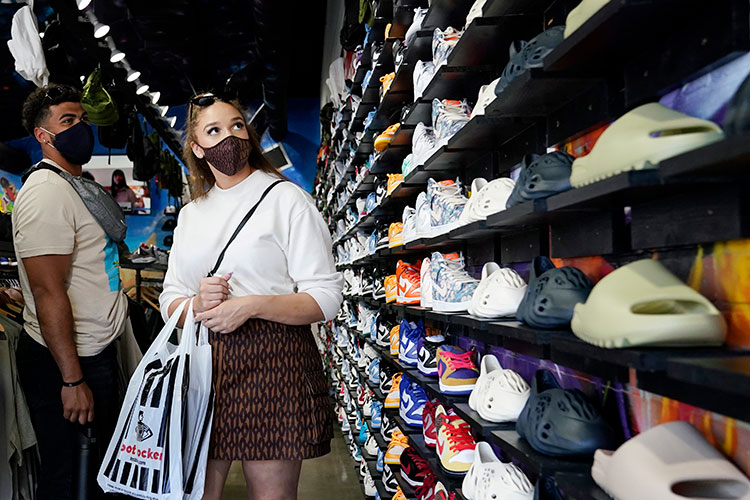
Shoppers wear masks inside of The Cool store on July 19, 2021, in the Fairfax district of Los Angeles, where public health officials recently reinstated an indoor mask mandate due to an uptick in COVID-19 cases. (AP photo by Marcio Jose Sanchez)
COVID-19: We can’t predict what’s next. But here’s what we can do now.
Not long after California’s June 15 grand reopening, a celebration of the lifting of most of its COVID-19 restrictions, a substantial uptick in cases prompted L.A. County to reinstate its indoor mask mandate. A number of Bay Area counties quickly followed suit, issuing strong recommendations, including for those who were vaccinated.To learn more about the dangers posed by the Delta variant and its effect on the future of the pandemic, Berkeley News spoke with Maya Petersen, chair of the biostatistics division at UC Berkeley’s School of Public Health and an expert in infectious diseases and epidemiology.

Anaïs Llorens, a French postdoc in the Helen Wills Neuroscience Institute, outside Barker Hall. Llorens and former postdoc Athina Tzovara say there are many ways individuals and institutions can improve conditions to ensure equity and diversity within academia. (Photo by Brittany Hosea-Small)
For neuroscientists, a checklist for eliminating gender bias
In 2019, Anaïs Llorens and Athina Tzovara — one a current, the other a former University of California, Berkeley, postdoctoral scholar at the Helen Wills Neuroscience Institute (HWNI) — were attending a scientific meeting and pleased that one session, on gender bias in academia, attracted nearly a full house. The problem: The audience of some 300 was almost all women. That was only one of the incidents that led the two women to round up 45 men and women from 40 institutions across 10 countries and 18 nationalities, divide them into small groups and task them with scouring the literature for practical tips — proven and unproven — on how best to counteract all aspects of gender bias in academia.
August

Yosemite National Park’s Illilouette Creek Basin in September 2018. (UC Berkeley photo by Emily Gonthier)
How wildfire restored a Yosemite watershed
For nearly half a century, lightning-sparked blazes in Yosemite’s Illilouette Creek Basin have rippled across the landscape — closely monitored, but largely unchecked. The result is approximately 60 square miles of forest broken up by patches of grassland, shrubland and wet meadows filled with wildflowers more abundant than in other parts of the forest. “It really is a glimpse into what the Sierra Nevada was like 200 years ago,” said Scott Stephens, a professor of environmental science, policy and management at UC Berkeley, co-director of Berkeley Forests and senior author of a new study that gathers together decades of research documenting how the return of wildfire has shaped the ecology of two creek basins in the Sierra Nevada since the the parks adopted policies to allow lightning-ignited fires to burn.
Also, listen: How wildfire can create healthier forests.

Xin Bi (center) helps his daughter, Emma Bi (not pictured) and her new roommate, Rae Xin, move into their new room. (Photo by Brittany Hosea-Small)
With new-student move-in, that old campus energy starts to return
UC Berkeley’s campus sprang to life in August as thousands of new students moved from their old homes to their new ones in the many residence halls across the campus. The transition marked a milestone for UC Berkeley — the official return of a fully vibrant campus after the COVID-19 pandemic pushed classes online and students, staff and faculty into socially isolated bubbles. Read more back-to-school stories and new student profiles.

A couple walks across Sproul Plaza as the sun filtered through a dome of smoke cast a strange orange glow over the landscape. The drought and recurring wildfires that signal climate change are among the many crises that have marked a coming of age for Berkeley students. (UC Berkeley photo by Irene Yi)
Seasons of change: How challenge and crisis will shape the pandemic generation
Students by the hundreds streamed through Sather Gate on a brilliant morning in August, en route to class, or the library, or the familiar comforts of the Free Speech Movement Café. It was such a pleasant scene, so familiar, and yet for Brianna Rivera, a UC Berkeley senior in English, it was skewing a little strange. She was walking to her first class of the semester, English 165, which will look at the classic 19th century novel Jane Eyre through the lens of Black women writers. A promising class, for sure, and yet she was struck — shocked, actually — by the masses of humanity. “That’s a lot for me, after having been in isolation for 18 months,” said Rivera, president of the Senior Class Council. No doubt thousands of students, staff and faculty were feeling something similar.
September

UC Berkeley’s new interdisciplinary Climate Equity and Environmental Justice faculty cluster. From left, Meg Mills-Novoa, Daniel Aldana Cohen, Maya Carrasquillo, Danielle Zoe Rivera and Zoé Hamstead. (Photo by Brittany Hosea-Small)
New faculty, hired in clusters, to address global issues, equity, justice
Five new faculty members at UC Berkeley inSeptember hailed from disparate U.S. states, academic disciplines and personal backgrounds. But they were already forming a team partnered around one critical global issue — climate equity and environmental justice — as part of six interdisciplinary faculty “cluster hires” underway on campus.

Ezinne Abba, a Cal track and field runner and junior in molecular and cell biology, breaks a school record in the women’s 100-meter sprint in May. (KLC Fotos photo by Eric Chang)
Breaking the cycle of shame about mental struggles in athletics
Long before sports superstars Naomi Osaka and Simone Biles braved the spotlight to defend their mental health, Graig Chow, a certified mental performance consultant at UC Berkeley, studied the culture that pushes elite athletes like NBA players Chamique Holdsclaw, Kevin Love and DeMar DeRozan to their breaking points. What he found was a top-down global sports establishment that has trouble differentiating between competitive anxiety and clinical mental disorders. By the time top athletes bow out of competitive events due to mental health struggles, they’ve likely endured years of stigma-induced shame, said Chow, the director of high performance and well-being at UC Berkeley’s Cameron Institute for Student-Athlete Development.
October

Professor David Card is best known for pioneering studies that questioned the prevailing assumptions about the impact of immigration on native-born U.S. workers and the effect of minimum wage. (UC Berkeley photo by Brittany Hosea-Small)
UC Berkeley’s David Card wins 2021 Nobel Prize in economics
In October, David Card, a labor economist and professor of economics at UC Berkeley, won the 2021 Nobel Memorial Prize in Economic Sciences for work that challenged orthodoxy and dramatically shifted understanding of inequality and the social and economic forces that impact low-wage workers. He was awarded half the prize, with the other half shared by economists Joshua Angrist of MIT and Guido Imbens of Stanford University.
Also, watch: UC Berkeley economist David Card’s Nobel Prize press conference and David Card’s first day as a Nobel winner, listen: How Nobel winner David Card transformed economics and view photos: Colleagues offer a heartfelt celebration for Nobel laureate David Card.
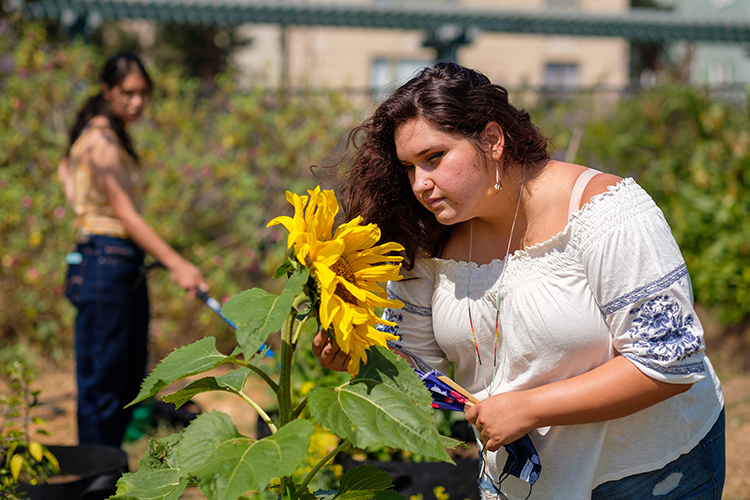
Student Jesmane Sanches admiringly examines a sunflower growing in the new Indigenous Community Learning Garden in the Oxford Tract. Nearby, Adina Lewis waters some of the many native plants growing there this fall. (UC Berkeley photo by Adam Sings in the Timber)
Berkeley’s new Indigenous Community Learning Garden takes root
In October, there was a new garden at UC Berkeley, but for Adina Lewis and other Indigenous people in the campus community, it’s much more than flora and fauna. The Indigenous Community Learning Garden is a place where both they and native plants can connect and thrive. On 1,050 square feet in the Oxford Tract, at the campus’s northwest corner, the four-month-old garden boasts Dakota Ivory corn, Cherokee Purple tomatoes, Chiletepin peppers, California buckwheat, tree mallow, white sage, native California grapes, California brittlebush and many other Indigenous and California native plants. Since June, students have been planting, tending and harvesting the crops, documenting their work, and learning and sharing stories about gardening done by their ancestors.
November

Grinnell in November when he was released after being treated for injuries caused by a rival falcon. (Photo courtesy of Cal Falcons)
Grinnell, Berkeley’s male peregrine, is injured by rival falcons
Grinnell, the campus’s beloved male peregrine falcon, was found injured southeast of campus following a fight with a pair of peregrine falcons and was treated at the Lindsay Wildlife Rehabilitation Hospital in Walnut Creek. The incident raised questions about whether he and Annie, his longtime mate, who likely also was there during the attack, could hold onto their home atop the Campanile, where they’ve raised their young for five years.
Also, read: As Grinnell heals, ‘soap opera’ in the skies continues at UC Berkeley, He’s back! Grinnell, UC Berkeley’s male falcon, returns to the Campanile and Three’s a crowd on the Campanile: Grinnell, Annie and a rival falcon.
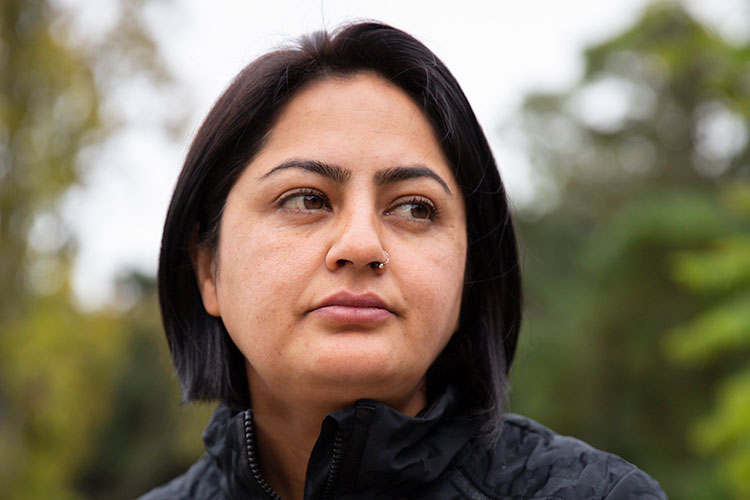
After the fall of Kabul, it took Khwaga Ghani and some members of her family nearly two months to escape Afghanistan and make their way to California. She is the first fellow in an ambitious program, co-sponsored by UC Berkeley, to support Afghan refugees — and she’s already thinking about how she can get back to Kabul to continue her work as a journalist. (Photo by Brittany Hosea-Small)
Taliban gunshots echo through Khwaga Ghani’s new life at Berkeley
For Khwaga Ghani, the memories are so immediate: an August morning in Kabul. An informal outdoor meeting with colleagues, interrupted by the startling crack of gunshots. People scattering in search of safety. Separated from her colleagues and urgently making her way across the Afghan capital toward her family’s home. Taking rides from perfect strangers, at other times running as fast as her sneakers would carry her, the lone woman among throngs of panicked men fleeing from the Taliban. Today, Ghani is safe in California, the first fellow in an ambitious program organized by UC Berkeley’s Human Rights Center, San Jose State University’s Human Rights Institute and the UC Berkeley Afghan Student Association to bring threatened Afghan scholars to the Bay Area.
December

An artist’s rendition of Quetzalcoatlus northropi, a type of pterosaur and the largest flying animal that ever lived on Earth. Quetzalcoatlus stood about 12 feet tall and walked with a unique gait because of its enormous 20-foot wings, which touched the ground when folded. (Artwork courtesy of James Kuether)
Fleshing out the bones of Quetzalcoatlus, Earth’s largest flier ever
Look around any wetland today and you’re likely to see 3-foot-tall egrets or 4-foot-tall herons wading in the shallows in stealthy search of fish, insects or crustaceans. But 70 million years ago, along the Rio Grande River in Texas, a more impressive and scarier creature stalked the marshes: the 12-foot-tall pterosaur known as Quetzalcoatlus. With a 37- to 40-foot wingspan, it was the largest flying animal that ever lived on Earth. In six papers published in December as a Memoir by the Society of Vertebrate Paleontology, scientists and an artist provide the most complete picture yet of this dinosaur relative, the largest example of which is represented by just a single set of fossilized bones collected in the late 1970s from Big Bend National Park.

The renovated Woo Hon Fai Hall will officially open in February 2022. Preserved during the redesign was the dramatic skylit gallery space. Ramps in the five-tiered structure were re-sloped and a freight elevator was converted to make the building more accessible for people with disabilities. (Photo by Brittany Hosea-Small)
A first look inside UC Berkeley’s Bakar BioEnginuity Hub
The wait for UC Berkeley’s bold new home for research and innovation is nearly over. After two years of construction, the Bakar BioEnginuity Hub (BBH) is scheduled to open in February 2022. The world-class facility pairs the Bakar Labs incubator with fellowships and programming for Berkeley students and researchers, equipping current and aspiring entrepreneurs in the STEM world with labs, offices, equipment and shared community spaces that aim to encourage collaboration. And all of this is just steps away from campus.